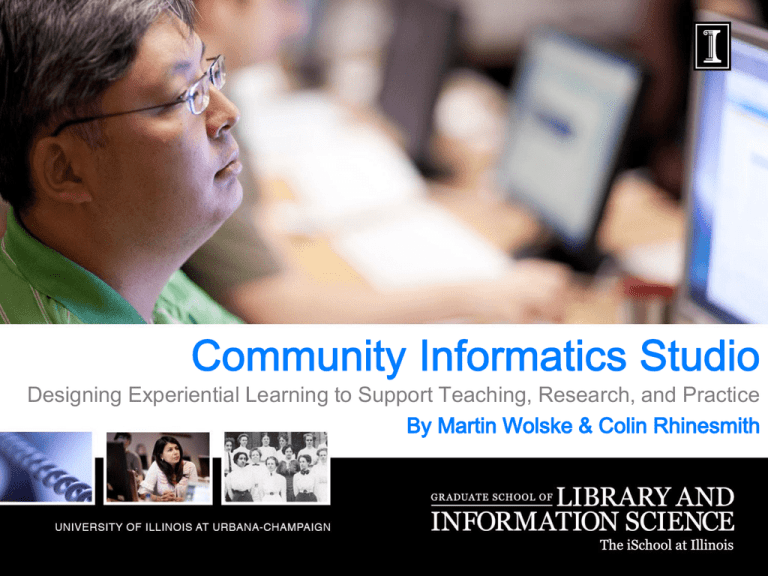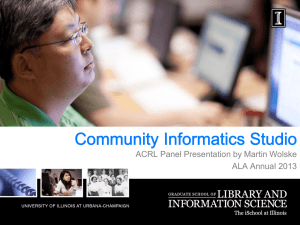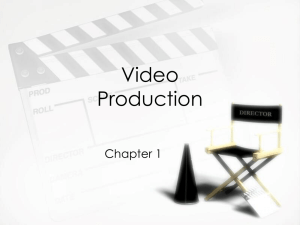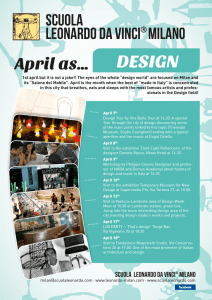Microsoft PowerPoint 2007
advertisement

Designing Experiential Learning to Support Teaching, Research, and Practice Affiliations • Senior Research Scientist, Center for Digital Inclusion, GSLIS at UIUC • Action Research Illinois Teaching, Research, and Practice • Engaged scholarship/boundary spanning, community inquiry, digital justice, equipping collaborative information & learning spaces 2 Affiliations • Doctoral Student & Research Scholar, Center for Digital Inclusion, GSLIS at UIUC • Adjunct Research Fellow, New America Foundation Teaching, Research, and Practice • Digital justice, community media & technology infrastructures, and U.S. communication policy 3 To open a conversation about how the Community Informatics Studio can be understood as a model of experiential learning to support LIS teaching, research and practice 4 Public libraries as community engagement leaders: • IMLS & American Library Association: “The Promise of Libraries Transforming Communities” (IMLS, 2012) • IMLS & MacArthur Foundation: “Learning Labs” (IMLS, 2011) • Knight Foundation: “Information Needs of Communities in a Democracy” (2009) 5 1. Introduce theoretical frameworks from community informatics, studio-based learning, and service learning literature. 2. Present three “Community Informatics Studio” case studies 1. Discuss how the CI Studio can prepare students to advance LIS-led community engagement projects 6 • “Using technology to support community development goals” (Stoecker, 2004) • “A sustainable approach to community enrichment that integrates participatory design of information technology resources, popular education, and assetbased development to enhance citizen empowerment and quality of life.” (Campbell & Eubanks, 2004) 7 (Bishop, Bruce, & Jeong, 2009) 8 • Learning to be a professional using master/apprentice model (Lackney, 1999) • Students’ “purposes” + current environment + teacher as guide = current learning (Dewey, 1938) • Iterative design process through desk critiques • Working within studio space provides important modeling of professional practice • Integral pedagogy in architecture and fine and applied arts. 9 • Day 1 – Introduce design problem/case • Early classes use readings and discussion to ground and prepare students to work in field • Field visits with community partners and model sites inform design • Instructor and outside experts ask students to defend design choices through desk critiques during scheduled sessions and informal conversations 10 Summer 2010: [Re]designing Public Computing Centers (PCCs) to better serve as collaborative information and learning spaces Summer 2011: Advancing the role of PCCs as community media newsrooms to address the disparity in effective use of information technologies in low-income communities Fall 2012: Using “Popular Technology” (Eubanks, 2011) to develop meaningful digital media literacy trainings with communities 11 Besides the specific design project accomplished with the community, each semester students created documents providing additional information for community members 2010: http://www.prairienet.org/op/labdesign/ 2011: http://www.prairienet.org/op/journalism/ 2012: http://www.prairienet.org/op/dmliteracy/ 12 How can the “Community Informatics Studio” be understood as a model of experiential learning to support LIS teaching, research, and practice? 13 Research Question: How does SBL compare to other forms of classroom learning? Theories: Community Inquiry (Dewey, 1939; Bishop, Bruce, & Jeong, 2009); Studio as Physical Space (Lackney, 1999; Brocato, 2009) Methods: Pre-/post-tests, class observations, discussions with students, interviews with instructor & teaching assistants 14 • Studio course set up as master/apprentice model • Initial lectures for background quickly give way to hands-on doing • Instructor’s “active guide” role, rather than passive sage, made a difference for students • Project-based approach fostered experiential learning environment (Kolb, 1984; Dewey, 1938) • Clients and class jointly owned the projects 15 Research Question: How important was the goal of equipping a community media newsroom to foster citizen journalism and community media? Theories: Community Media (Howley, 2009), Citizen Journalism (Gillmor, 2006), and Digital Storytelling (Lundby, 2009) Methods: Interviews with students, instructors, and community members 16 Course Structure • Course was too short • Too much time in the classroom Course Content • Shortage of community engagement literature • Citizen journalism framework too limiting 17 Training of community members • Lesson plans need to be flexible & adaptable • The combination of digital & media literacy is key • More writing & print newsletter projects are needed Community Engagement • Include families as a key target audience • Mentoring process can be effective with youth 18 “This was one of my favorite GSLIS classes. I’m not just saying that. It was because, well, I really enjoyed [instructor’s] teaching style because it’s very inclusive. I’ve never had another class like that here at GSLIS. Most classes here are not like that. They are quite the opposite. It’s a lot of feeding you facts and figures and processes and assignments that require regurgitation of those things, which is like a very traditional way of teaching. But I think [instructor’s] was the most experiential of any approach that I had while I was here. I mean you learn way too much from it—which is almost a problem [laughing].” – Student 19 “I learned a whole lot from this. I had a lot of personal growth, you know when you’re dealing with the community, community media, and just listening to their conversations. For our part, I think our success was at Dorsey Homes.” –LIS 490 ST Instructor 20 “I think with all the different programs, a lot of those kids will be kids that go to college. And they will think that I lived in the projects and look where I am now. Look where I am now. I think that is so important because I think when they see a U of I student, they think, ‘Where are you from and you come way down here to go to school?’ I just think that for those kids, and even these seniors when they see these college kids coming, it’s an opportunity for them to think, ‘I want to do this when I go to school. I want to get involved because it’s a great opportunity.” – Community member 21 Recommendations • Select readings that better prepare students for community engagement projects • Prepare students to help organizations develop & build capacity to use digital media • Provide students with opportunities to engage in “icebreaker” & “trust-building” activities to help strengthen relationships with community partners • Create opportunities for youth to visit University 22 Research Question: How can studio-based learning (SBL) – informed by perspectives from community informatics – prepare students to advance LIS-led community engagement? Theories: Addams (1902), Dewey (1938), Freire (1970/1993), Eubanks (2011), (Stoecker, 2013) Methods: Student journals & desk-critiques; interviews with students, instructors, & community; observations 23 Based on our experience teaching: Challenges • Institutional system that’s not setup to readily support community based research • The blurring of teaching, research, and practice Benefits • Helping students to develop meaningful LIS-led community engagement projects • Difference as a resource; liberating knowledge; shared ownership 24 • Three different sets of research questions, theoretical frameworks & methodologies - Questions driven by funding sources - Research led by different researchers • Discovered core research question over time 25 We believe that to fully capitalize on studiobased learning to advance LIS-led Community Engagement, the following Community Informatics values are key: • • • • • • Sustainable Approach to Community Enrichment Asset-Based Perspective Popular Education & Participatory Design Difference is a Resource Teach, Research, & Practice with Community Building Healthy Communities 26 How can the Community Informatics Studio can be understood as a model of experiential learning to support LIS teaching, research and practice? • Studio pedagogy resonates strongly with students because it is rooted in experiential learning • Studio pedagogy invites students into research on current topics in LIS through the design problem • Studio pedagogy compliments the rich tradition of practical field experience commonly found in LIS education 27 Addams, J. (1902). Democracy and social ethics. New York, NY: Macmillan Co., 1902. Barker, R. G. (1968). Ecological psychology: Concepts and methods for studying the environment of human behavior. Palo Alto, CA: Stanford University Press. Bishop, A., Bruce, C., & Jeong, S. (2009). Beyond service learning. In (Eds.) Service learning: Linking library education and practice. Chicago, IL: American Library Association. Brocato, K. (2009). Studio based learning: Proposing, critiquing, iterating our way to person-centeredness for better classroom management. Theory Into Practice, 48, 138-146. 28 Campbell, N. D. & Eubanks, V. (2004). Community informatics as a pathway to social change. Available at http://www.brillomag.net/COPC/CI/ Canter, D.V. & Craik, K.H. (1981). Environmental psychology. Journal of Environmental Psychology 1, 1-11. Computer Professionals for Social Responsibility. (1999). Participatory design history. Retrieved from http://cpsr.org/prevsite/conferences/pdc98/history.html/ Dewey, J. (1938). Experience and education. New York, NY: The Macmillan company. Eubanks, V. (2011). Digital dead end: Fighting for social justice in the information age. Cambridge, MA: The MIT Press. 29 Freire, P. (1970/1993). Pedagogy of the oppressed. New York, NY: Continuum. Gillmor, D. (2006). We the media: Grassroots journalism by the people, for the people. Sebastopol, CA: O'Reilly. Hamilton, D. K.. & Watkins, D. H. (2009). Evidence-based design for multiple building types. Hoboken, NJ: Wiley. Institute of Museum and Library Services (2012). IMLS awards ala grant to advance library-led community engagement. Retrieved from http://www.imls.gov/imls_awards_ala_grant_to_advance_libraryled_community_engagement.aspx 30 Institute of Museum and Library Services. (2012). Learning labs in libraries and museums. Retrieved from http://www.knightcomm.org/read-thereport-and-comment/ The Knight Commission on the Information Needs of Communities in a Democracy (2009). Informing communities: Sustaining democracy in the digital age. Retrieved from http://www.knightcomm.org/read-the-reportand-comment/ Lackney, J. A. (1999). A history of the studio-based learning model. Retrieved online from http://www.edi.msstate.edu/work/pdf/history_studio_based_learning.pdf Kolb, D. A. (1984). Experiential learning: Experience as the source of learning and development. Englewood Cliffs, N.J.: Prentice-Hall, Inc. 31 Lundby, K. (Ed.) (2009). Digital storytelling, mediatized stories: Selfrepresentations in new media. New York, NY: P. Lang. Nussbaumer, L. L. (2009). Evidence-based design for interior designers. New York, NY: Fairchild Books. Reardon, K. (2000). An experiential approach to creating an effective community-university partnership: The east st. louis action research project. Cityscape: A Journal of Policy Development and Research, 5(1), pp. 59-74. Rogers, E.M. (2005). Diffusion of innovations (5th ed). New York, NY: Free Press. 32 Stoecker, R. (2005). Is community informatics good for community? Journal of Community Informatics, 1(3). Retrieved from http://www.cijournal.net/index.php/ciej/article/view/183/129 Stoecker, R. (2013). Research methods for community change: A project-based approach. Thousand Oaks, CA: Sage Publications, Inc. 33 Contact • Martin Wolske: mwolske@illinois.edu • Colin Rhinesmith: crhines@illinois.edu Presentation URL http://go.illinois.edu/cistudio_alise13 34







